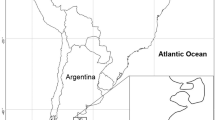Abstract
The lichenEndocarpon pusillum Hedw. was cultivated under laboratory conditions on agar, silica gel and soil substrate. Selected developmental stages of the life cycle (germination, contact between the symbionts, cortex, squamule and perithecia development) were studied by light and scanning electron microscope.—It could be shown that the spores had no rigid spore walls with germination colpies and the spore cells which are in contact with the substrate were formed directly into germination tubes.— Further studies showed that the initial contact between the components was thigmotropic and both the form and the gelatinous matrix around the algal cells play an important role in this process. — The development of the cortex occurs under reduced moisture conditions resulting in a reduced algal reproduction. The thickness of the cortex was dependent on light intensity during cultivation. The cortex originated from hyphae, which developed beyond the algal layer and were combined to a tight network.—Fruiting bodies with spores and hymenial algae were only formed in cultures on soil substrate.
Similar content being viewed by others
Literatur
Ahmadjian, V., 1966: Artificial reestablishment of the lichenCladonia cristatella. — Science151, 199–201.
—, 1982: Algal/fungal symbioses. — InRound F. E., Chapman, D. J., (Eds.): Progress in Phycological Research1, pp. 179–233. — Amsterdam: Elsevier Biomedical Press, B. V.
—, 1970: The culture and synthesis ofEndocarpon pusillum andStaurothele clopima. — Lichenologist4, 259–267.
—, 1970: The ultrastructure of lichens. III.Endocarpon pusillum. — Lichenologist4, 268–270.
Ahmadjian, V., Russell, L. A., 1978: Scanning electron microscope study of early lichen synthesis. — Science200, 1062–1064.
—, 1981: Relationship between fungus and alga in the lichenCladonia cristatella Tuck. — Nature289, Nr. 5794, 169–172.
—, 1982: Artificial reestablishment of lichens. III. Synthetic development ofUsnea strigosa. — J. Hattori Bot. Lab.52, 393–399.
- - 1983: Algal-fungal relationships in lichens: recognition, synthesis and development. — In Goft, L., (Ed.): Algal Symbiosis, pp. 147–172. — Cambridge Univ. Press.
—, 1985: Artificial reestablishment of lichens. 4. Comparison between natural and synthetic thalli ofUsnea strigosa. — Lichenologist17, 149–165.
Anderson, T. T., 1951: Techniques for the preservation of three-dimensional structure in preparing specimens for the electron microscope. — Trans. New York Acad. Sci., Ser.11 (13), 130.
Bertsch, A., Butin, H., 1967: Die Kultur der ErdflechteEndocarpon pusillum im Labor. — Planta72, 29–42.
Bold, H. C., 1942: The cultivation of algae. — Bot. Rev.8, 69–138.
Bubrick, P., Galun, M., 1980a: Symbiosis in lichens: Differences in cell wall properties of freshly isolated and cultured phycobionts. — FEMS Microbiology Letters7, 311–313.
—, 1980b: Proteins from the lichenXanthoria parietina which bind to phycobiont cell walls. Correlation between binding patterns and cell wall phytochemistry. — Protoplasma104, 167–173.
Deason, T. R., Bold, H. C., 1960: Phycological studies. I. Exploratory studies of Texas soil algae. — Univ. Texas Publ.6022, 1–70.
Esser, K., 1976: Kryptogamen: Blaualgen, Algen, Pilze, Flechten. — Berlin, Heidelberg, New York: Springer.
Geitler, L., 1938: Beiträge zur Kenntnis der Flechtensymbiose. VII. Über Hymenialgonidien. — Arch. Protistenk.90, 489–501.
Honegger, R., 1982: Cytological aspects of the triple symbiosis inPeltigera aphtosa. — J. Hattori Bot. Lab.52, 379–391.
—, 1984: Cytological aspects of the mycobiont-phycobiont relationship in lichens. — Lichenologist16 (2), 111–127.
—, 1985: Fine structure of different types of symbiontic relationships in lichens. — InBrown, D. H., (Ed.): Lichen Physiology and Cell Biology, pp. 287–302. — New York, London: Plenum Press.
Inoue, Y., Furuya, M., 1975: Perithecial formation inGelasinospora reticulispora. IV. Action spectra for the photoinduction. — Pl. Physiol.55, 1098–1101.
Lilly, V. G., Barnett, H. L., 1951: Physiology of the Fungi. — New York: Mc Graw-Hill. Co., 464 pp.
Malone, C. P., 1977: Observations onEndocarpon pusillum: The role of rhizomorphs in asexual reproduction. — Mycologia69 (5), 1042–1045.
Neuhaus, G., 1980: Rasterelektronenmikroskopische Untersuchungen an Desmidiaceen mit besonderer Berücksichtigung der Poren und ihrer Verteilung. — Diss. Thesis, Botan. Institut d. Univ. Salzburg.
Stahl, E., 1877: Beiträge zur Entwicklungsgeschichte der Flechten. II. Über Hymenialgonidien. — Leipzig: Felix.
Stocker-Wörgötter, E., 1985: Licht- und rasterelektronenmikroskopische Untersuchungen über die Entwicklung und das Wachstum von Flechten verschiedener Wuchsform unter Kulturbedingungen. — Diss. Thesis, Bot. Institut d. Univ. Salzburg.
Thomas, E. A., 1939: Über die Biologie von Flechtenbildnern. — Beiträge der Kryptogamenflora d. Schweiz9 (1). — Bern: Büchler.
Werner, R. G., 1931: Histoire de la Synthèse lichénique. — Mém. Soc. Sci. Nat. Maroc.27, 7–45.
Author information
Authors and Affiliations
Additional information
Frau Prof. Dr.Elisabeth Tschermak-Woess zu ihrem 70. Geburtstag gewidmet.
Rights and permissions
About this article
Cite this article
Stocker-Wörgötter, E., Türk, R. Licht- und elektronenmikroskopische Untersuchungen von Entwicklungsstadien der FlechteEndocarpon pusillum unter Kulturbedingungen. Pl Syst Evol 158, 313–328 (1988). https://doi.org/10.1007/BF00936353
Received:
Issue Date:
DOI: https://doi.org/10.1007/BF00936353




